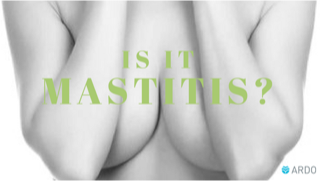Your milk ducts are areas of your breast where milk flows. When this becomes clogged you may notice a lump or area of engorgement that might be hot, swollen and red. With a clogged duct you will otherwise feel normal. If you think you have a clogged duct click here.
If you have mastitis or inflammation of the breast, you may experience more intense pain, heat and swelling of the breast. There might even be red streaks in the painful area. Mastitis also comes with flu-like symptoms such as fever, aching and malaise. This can all come on quite suddenly. If you think that you only have a clogged duct then go back to the previous paragraph and click the link because untreated clogged ducts can turn into mastitis. Mastitis is more miserable than a clogged duct. Be sure to take a clogged duct seriously and treat it immediately so that it doesn’t escalate to mastitis.
Who would think to unleash such misery onto us when we are trying to take care of a newborn baby and figure out breastfeeding?! Well, it doesn’t come out of nowhere. We know the causes. A clogged duct can come from latching problems, skipping feedings or feeding on a schedule (meaning not breastfeeding on demand), oversupply, sleeping on your belly, nursing strikes, baby sleeping long periods of time, tight bras, basically anything that restricts the flow of milk causing engorgement. Mastitis is caused by an untreated clogged duct or an infection in the breast that can enter through open wounds.
Many women worry that they need to stop nursing. Not true! Keep nursing and emptying the breast frequently. This will help to unclog the duct or get rid of the infection. You can dangle your breast over your baby to let gravity lend a hand. But remain as comfortable as possible and allow room for breast massage of the affected area while nursing. When your baby is done nursing or if you cannot breastfeed then pump frequently. Empty as much milk from your breast as possible as frequently as possible.
Keep the breast warm with a towel, hot shower or bath or even submerge your breast in a bowl of warm water. Massage your breast in the direction of the nipple to help draw out the clog or infection.
Drink plenty of fluids and rest as much as possible. Remove restricting clothing. You can use cold compresses between treatments for pain management.
You might actually see the clog come out of your nipple. Such satisfaction! But don’t be surprised that it might be stringy, grainy or fatty. This is not at all harmful to your baby. The tenderness in your breast may continue for a few more days.
Mastitis does not always require antibiotics, but do not hesitate to contact your doctor or midwife if your symptoms have not improved in 24-48 hours. Take antibiotics if they are recommended. Mastitis can escalate to an abscess if not treated. If you do need to take antibiotics, consider using a probiotic to decrease your risk of developing thrush (yeast infection).
You can read more about Mastitis here.
https://kellymom.com/bf/concerns/mother/mastitis/
https://www.askdrsears.com/topics/feeding-eating/breastfeeding/common-problems/mastitis
http://ibconline.ca/information-sheets/blocked-ducts-mastitis/

